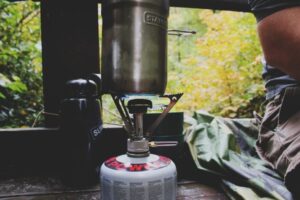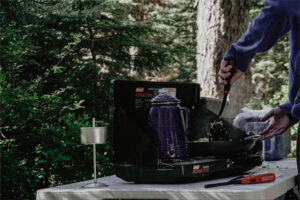
Fire starting is a broad topic and with thousands of years of evolution in the skill set, there are several approaches to creating fire, ranging from the most primitive friction-fire techniques to the most contemporary tinder and electronic lighters. You could spend a lifetime researching all of the many ways to produce fire. But if you simply want to understand the most effective and have a few tried-and-true ways for when you need a fire, this article is for you.
How to Start a Campfire in 6 Steps
Follow this effective method for building a fire.
Create a fire ring:
Choose a flat area on the ground to build your fire. Use your hands to form a circular space free of rocks and trash. Form a ring around the clean space with the rocks you’ve removed. If you have a shovel, you can dig a fire pit. (In inclement weather, a fire pit may be essential).
Use small sticks to create a platform:
To cover the base of your fire ring, place many tiny sticks or twigs flat on the ground. This creates a platform for airflow beneath the tinder.
Build up tinder:
Next, arrange dried grass, leaves, birch bark, and/or pine needles on top of the sticks. You may also use cotton balls, dryer lint, or sawdust if you have any.
Light the fire:
If you have matches or a lighter, use them to ignite the tinder. You may also use flint or a bow drill to start the fire.
Slowly add kindling:
Break apart little pieces of wood using a hatchet or knife. Add several tiny pieces of firewood to the burning tinder. Gradually add larger pieces until you have a huge flame.
Add larger logs:
Begin to add bigger logs to a teepee or log home structure. Use dry wood to avoid excessive smoking and smoldering.
5 Materials Needed to Start a Fire
Here are the supplies you will need to build a fire.
Matches, lighter, or flint stick:
Each fire requires a flame. To fire the tinder, use a lighter or match. In the lack of matches or a lighter, a flint stick can help you start a fire.
Tinder:
The fuel you utilize should always begin with tinder. Think of tinder as a light, fluffy fuel that can be ignited with a single spark. Birch bark, dried leaves that have not fallen from trees, genuine old bird’s nests, and cedar bark are also popular sources of fine natural tinder. This form of fuel is likely to flare and burn briefly, but it serves as a starting point for your campfire. After tinder, the next sort of fuel to employ is kindling.
Kindling:
Kindling is more solid than tinder, but unlike tinder, it is unlikely to ignite with a single spark. Kindling will light with a little exposure to a flame and can be found on the land ready to go in the form of “squaw wood” found on the bottom of evergreen trees or trimmed down to size from a bigger piece of firewood. Kindling is the thickness of pencil lead, and it should fracture when bent. There is an ancient saying: “If it doesn’t crack, throw it back.” The best kindling comes from softwoods such as conifers, which burn very hot and quickly. It’s not the sort of wood you want to burn in your campfire all night, but it’s the ideal for getting it started.
Firewood:
You will need a variety of firewood sizes. Use smaller bits for the initial fire-starting phase, then larger ones to keep the fire going over time.
Fire extinguisher:
Though not required for starting a fire, having a dependable technique to extinguish one is suggested, whether it be a fire extinguisher or a bucket of water.
6 Tips for Starting a Fire
Whether you’re an avid camper or a beginner fire-builder, improve your fire-making skills with these tips.
Keep a flint stick on hand when camping or backpacking:
When traveling into the bush, carry a flint stick on hand. A flint stick is composed of flammable magnesium. The tool comes with a steel striker. Use a striker (or a knife) to create magnesium shavings on top of dry tinder. Knock the striker against the stick to create sparks over the shavings. The sparks will ignite the shavings, setting the tinder on fire.
If the ground is wet, build an upside-down fire:
When the moist forest floor threatens to soak your kindling, start your fire upside down. Place three to four bigger logs on the bottom, followed by smaller logs rotated at a 90-degree angle and stacked on top. Repeat with progressively smaller pieces of wood. Top with Tinder and kindling.
Practice the bow drill method:
The bow drill method generates an ember by friction. It has a fireboard, hand drill, and bowstring. Rapidly rub the hand drill against the fireboard until enough heat is generated to form an ember, which may then be used to start a fire.
Use the battery and steel wool method:
With a nine-volt battery and steel wool, you can quickly ignite a fire. Put a tiny bundle of steel wool in the center of your tinder. Make contact with a nine-volt battery, and the steel wool should ignite quickly.
Create a fire using a magnifying glass:
In a pinch, a magnifying glass may harness the sun’s heat to ignite a fire. Hold the magnifying glass up to the sun, resulting in a focused beam of light on your tinder. If the weather is appropriate, it should generate enough heat to form an ember.
Make s’mores:
S’mores are the ideal campfire dessert, with toasted marshmallows and molten chocolate squeezed between two graham cracker halves.





